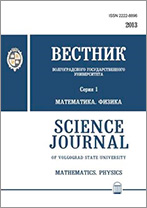|
|
Vestnik Volgogradskogo gosudarstvennogo universiteta. Seriya 1. Mathematica. Physica, 2014, Issue 5(24), Pages 62–72
(Mi vvgum24)
|
 |
|
|
This article is cited in 2 scientific papers (total in 2 papers)
Computer modelling
Computer simulations of photoexcitation processes in donor-acceptor complexes
C. V. Feskov, S. N. Osipova
Volgograd State University
Abstract:
Short laser pulses with femtosecond timescale duration are now widely used to study the kinetics of ultrafast photochemical reactions in electron donor-acceptor complexes [1; 8]. In many chemical systems, femtosecond spectroscopy allow to detect the molecular structure of the short-lived reaction intermediates, that is to reveal the microscopic mechanisms of chemical transformations. However analysis of experimental data requires the detailed and exact mathematical model for the process considered. The most appropriate description for electron transfer (ET) reactions in polar solvents provides the stochastic approach [9]. This approach utilizes the concepts of solvent polarization mode, parabolic electronic term, resonant electronic transitions in term-crossing point, diffusive motion of the particles along the solvent reaction coordinates and allows to calculate the reaction kinetics in donor-acceptor complexes (DACs) in a wide range of energetic parameters.
Many studies on ultrafast reactions in DACs admit the optical excitation of DAC to proceed instantaneously, that is faster than any chemical transformations or relaxation processes in molecular system and solvent. This assumption is not however always true if one considers non-thermal ET in multi-mode solvents having significant inertial component of relaxation. In these experiments the duration of laser pulse can be comparable and even exceed the characteristic timescale of chemical reaction, which makes the «instant pump» approximation a doubt.
In this study a model of ultrafast ET in DACs, explicitly accounting for the dynamics of optical excitation as well as recombination of charges, is developed. The model is applicable to photochemical reactions initiated by laser pulses with a broad spectral band, considerably exceeding the range of the DAC excitation frequencies. The applicability of the model to real molecular systems and solvents is discussed, estimations for the allowable values of model parameters are made. Computational schemes, compatible with the recrossing algorithms for ultrafast ET simulations [2; 3], are proposed. The first scheme employs sampling the «time of excitation» for each quasiparticle from the gaussian distribution with the standard deviation $\sigma = \tau_e/\sqrt2$, with $\tau_e$ being the pump pulse duration. The second one involves generation of random optical transitions for quasiparticles on each simulation time-step. Analytic expression for the probability of such event is derived.
The proposed computational algorithms are implemented within the QM2L software package. The results of test simulations, as well as comparison with known exact solution of the model equations in the particular case (absence of recombination), verify the accuracy of the algorithms developed.
Keywords:
computer simulations in chemistry, brownian simulations, random trajectories method, femtochemistry, nonequilibrium photochemical systems.
Citation:
C. V. Feskov, S. N. Osipova, “Computer simulations of photoexcitation processes in donor-acceptor complexes”, Vestnik Volgogradskogo gosudarstvennogo universiteta. Seriya 1. Mathematica. Physica, 2014, no. 5(24), 62–72
Linking options:
https://www.mathnet.ru/eng/vvgum24 https://www.mathnet.ru/eng/vvgum/y2014/i5/p62
|

| Statistics & downloads: |
| Abstract page: | 148 | | Full-text PDF : | 61 | | References: | 38 |
|




 Contact us:
Contact us: Terms of Use
Terms of Use
 Registration to the website
Registration to the website Logotypes
Logotypes







 Citation in format
Citation in format 
